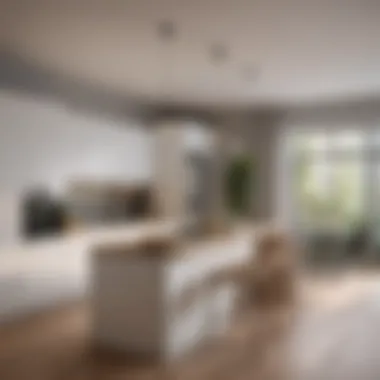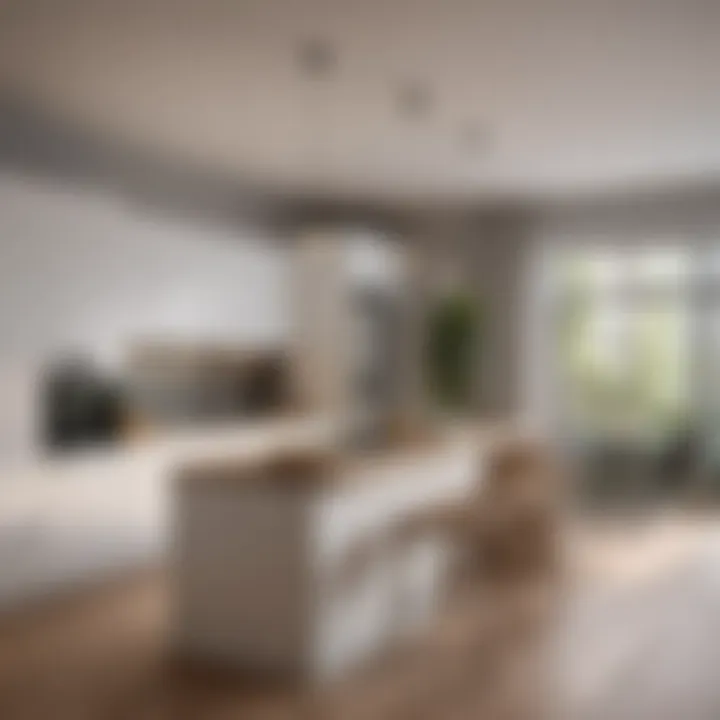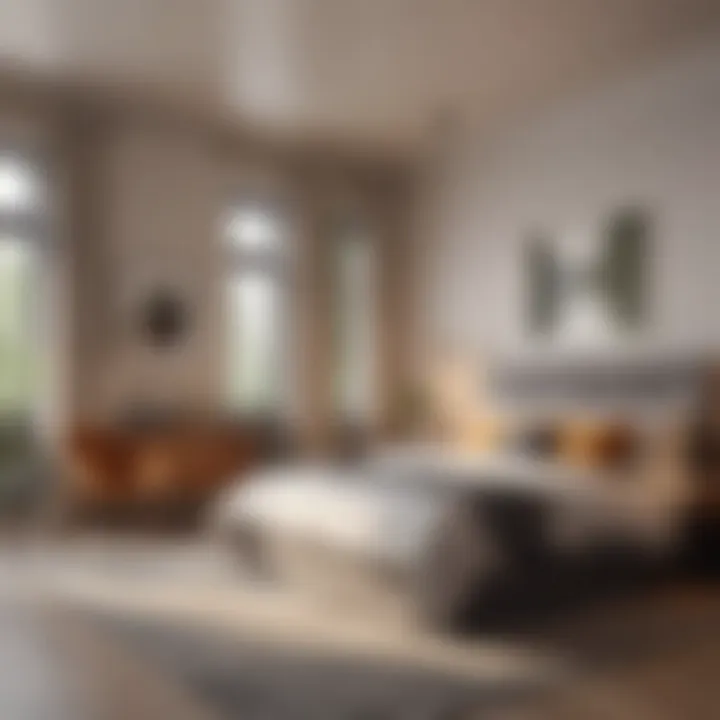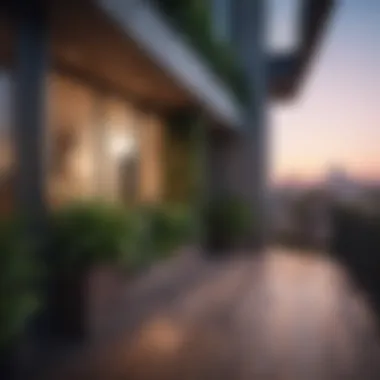Exploring Average One-Bedroom Apartments in Urban Areas


Intro
When one thinks of the quintessential urban dwelling, the average one-bedroom apartment often comes to mind. Not just a simple space to hang one's hat, these apartments epitomize a lifestyle choice for many city dwellers. It's a bit like picking the right tool for a job; the fundamental elements—space, design, and location—combine to create a unique living experience.
In modern cities, these apartments aren't merely a stepping stone towards home ownership but rather an attractive option in their own right. As such, it's crucial to delve into what makes an average one-bedroom apartment tick.
Indeed, the allure of these spaces lies in their versatility and the infinite design possibilities they offer. From bustling metropolitan areas to quieter suburban settings, each apartment tells a story, infused with the culture and character of its surroundings. By dissecting the various layers that make up these living spaces, potential renters and buyers can better comprehend their choices and evaluate them against personal needs and desires.
In the sections that follow, we will explore everything from the architectural highlights that define these homes to the broader trends impacting their pricing and popularity.
Featured Homes
Architectural Highlights
The beat of the city often influences the architecture of one-bedroom apartments. Whether it’s an Art Deco gem in Miami or a modernist marvel in San Francisco, the difference in design aesthetics can astound even the most seasoned observer. The most captivating one-bedroom apartments often blend functionality with artistic expression. Clear lines, open spaces, and large windows are just the tip of the iceberg.
- In New York, for instance, it’s common to find older buildings that incorporate classic brownstone elements, giving each home a sense of history.
- Building styles in Seattle may lean more towards contemporary and sustainable designs, with a focus on maximizing space through innovative layouts.
Material choice is also fundamental in defining architectural highlights. Natural materials like wood and stone can lend warmth and character, transforming a simple living space into a sanctuary.
Interior Design Themes
The interior design of one-bedroom apartments often mirrors broader lifestyle preferences, balancing aesthetics with functionality. The themes vary greatly across regions and bear distinct influences:
- Minimalistic: Popular in urban centers like Tokyo, this theme emphasizes decluttering, with clean lines and muted color palettes.
- Eclectic: In cities such as Austin, a mix of vintage items and bold decor can create a lived-in charm that reflects the owner’s personality.
The challenge, of course, is to maximize every square inch. Considerations such as multi-functional furniture or open shelving can easily enhance spatial perception while adding layers of interest.
"A well-designed one-bedroom apartment should feel open and inviting while still providing a sense of intimacy."
Living in such a space offers a canvas for personal expression and creativity.
Location Spotlights
Cultural Significance
In the realm of one-bedroom apartments, location is paramount. The culture surrounding them helps shape their desirability and value. An apartment in a vibrant neighborhood, riddled with cafes, art galleries, and parks can change the experience of urban living entirely. Cities like Paris, known for their artistic flair, often appeal to those looking for inspiration woven into their daily lives through the environment.
Natural Wonders
Equally important are the natural elements that can enhance urban living. Imagine a one-bedroom apartment with a view of mountains in Vancouver or overlooking a serene waterfront in Chicago. These natural wonders not only serve as a backdrop but also as an essential part of the city's identity.
In closing, the exploration of average one-bedroom apartments can shed light on spatial utilization, urban trends, and personal expression. For many, these homes are more than just a roof overhead; they embody a lifestyle that reflects individuality in an ever-evolving urban landscape.
Understanding One-Bedroom Apartments
Understanding one-bedroom apartments is crucial for those navigating the tight grid of urban living. These spaces often serve as a bridge between cozy solitude and a bustling city life. With a typical one-bedroom apartment, renters have more than just a roof over their heads; they gain a domain that reflects their lifestyle and aspirations within a compact footprint.
In urban areas, where real estate prices can often leave the average person baffled, one-bedroom apartments often strike a balance. They provide a sense of privacy and independence, especially for young professionals or couples without children. However, understanding what comprises a one-bedroom unit goes beyond knowing its definition; it includes grasping its characteristics, typical layouts, and how these spaces can cater to different preferences and needs.
Definition and Characteristics
A one-bedroom apartment is generally defined as a dwelling designed for single or dual occupants, featuring a separate bedroom, a living area, kitchen, and bathroom. But the characteristics can vary significantly. These units may come with different organizational perks like open-concept layouts or traditional divisions that offer versatility and foster personal expression.
Specific traits include:
- Kitchen Size: Ranges from galley-style to spacious eat-in options.
- Bathroom Configuration: Can be a separate full bath or an en suite arrangement.
- Living Space: Varied dimensions influence how one can functionally utilize the space.


One-bedroom apartments are often sought for their balance of comfort and minimalism. They provide an intimate setting that can be adorned to one’s taste without overwhelming clutter. For many, it’s the perfect spot to retreat after a long day, making the environment an essential element to consider.
Typical Size and Layout
When it comes to size, the average one-bedroom apartment typically spans between 600 to 800 square feet, but this can fluctuate based on the city or specific neighborhood. Urban locations with high demand might squeeze that size down to the bare minimum, while less populated areas could offer more generous squares.
The layout usually consists of:
- Defined Sleeping Area: The bedroom shouldn't just fit a bed but allow for nightstands and closet space.
- Functional Living Area: A lounge space for entertaining or unwinding, often adjacent to the kitchen.
- Access Points: Consider how the layout will affect flow and functionality; a poorly planned layout can cause awkwardness in daily routines.
Additionally, there’s a rise in creativity surrounding layouts. For instance, some buildings incorporate multi-functional spaces, where rooms can serve dual purposes. This approach enhances the usability of a limited footprint while catering to varying lifestyles.
In summary, knowing more about one-bedroom apartments isn’t just academic; it shapes informed decisions for potential renters or buyers by marrying their needs with the right space.
Cost Factors Affecting One-Bedroom Apartments
Understanding the cost factors affecting one-bedroom apartments is like peering into the inner workings of the housing machine. It is not just about the sticker price; a medley of elements plays a role in shaping the financial landscape for potential renters and buyers. These factors can often be the difference between a comfortable living arrangement and a financial burden. As people navigate the maze of urban living, uncovering the nuances of pricing can help inform decisions that resonate with their lifestyle and budget.
Price Variation by Location
One of the first things one notices when searching for a one-bedroom apartment is how prices swing wildly depending on location. Renting in the heart of a bustling city like New York or San Francisco demands a different kind of financial commitment compare to more suburban areas. This variance often stems from several considerations:
- Supply and Demand: In sought-after neighborhoods, the availability of apartments may be low while demand remains high, driving prices upward. Conversely, more remote areas might offer more reasonable rents because of the surplus of available units.
- Local Economy: Areas with thriving job markets tend to see higher rents. For instance, tech hubs in the Silicon Valley region often spike rentals due to the influx of professionals seeking proximity to employers.
- Amenities and Infrastructure: Neighborhoods with better schools, parks, or public transport links often command higher prices. Living near a subway station or a popular café can make an apartment all the more desirable, regardless of its actual size or layout.
A potential buyer or renter should take time to explore not just the price tag of the apartment but the overall picture of what that location provides.
Impact of Market Trends
Market trends influence pricing like seasons affect the weather. The real estate market is notoriously cyclical, with certain times of the year proving to be more advantageous for renters. For example, during the summer months, college students are often on the hunt for new places, which can push rental prices up in college towns. Factors influencing market trends include:
- Economic Shifts: A boost in the economy can spur more individuals to seek independence from shared housing, increasing demand for one-bedroom units and, consequently, prices.
- Government Policies: Tax incentives, zoning changes, or new housing guidelines can sway market dynamics, impacting availability and pricing. Similarly, rising interest rates can lock potential buyers into rented properties for extended periods, thus elevating demand for rentals.
- Cultural Shifts: Changes in work habits, such as remote work becoming commonplace, can shift interest away from urban locations into more suburban or rural areas, impacting pricing accordingly.
Staying abreast of these trends can not only guide potential renters in their search but also arm future buyers with knowledge that can result in securing a better deal.
Cost of Utilities and Maintenance
While base rent is the primary concern for most, the cost of utilities and maintenance can silently creep into the overall expense of managing a one-bedroom apartment. This reality often takes renters off guard if they have not factored it into their budget:
- Utility Expenses: Depending on the location, utilities such as water, electricity, gas, and internet can add a noticeable chunk to monthly costs. For instance, an apartment in a colder region might see higher heating bills during winter, whereas humid areas might rack up air conditioning expenses in the summer.
- Maintenance Fees: Not all apartments come with the same maintenance arrangements. Some buildings charge monthly maintenance fees that cover amenities or upkeep. It's essential to be aware of such charges upfront, as they can vary widely and impact one's overall monthly budget.
- Insurance Costs: Don’t overlook renters insurance. Many landlords now require it, adding another layer to the monthly bills and, in turn, the total cost of living in the apartment.
Being well-informed about these additional costs helps ensure that living in a one-bedroom apartment stays within financial reach, rather than becoming an unplanned weight on one’s finances.
"Understanding the full scope of expenses associated with renting or buying a one-bedroom apartment can save you from unexpected financial strain."
Design Trends in One-Bedroom Apartments
In today's fast-paced urban living, design trends in one-bedroom apartments play a crucial role in making these compact spaces functional and visually appealing. As people seek more than just a shelter, they aim for a home that reflects their personality and meets their lifestyle needs. With the right design, these apartments can be transformed from merely functional to extraordinary. This section explores two significant aspects of modern design in one-bedroom apartments: Minimalist Aesthetics and Maximizing Space Efficiency.
Minimalist Aesthetics
Minimalist aesthetics have gained substantial traction among one-bedroom apartment seekers for good reason. The idea is simple: less is more. This design approach emphasizes simplicity, clean lines, and uncluttered spaces, making it easy on the eyes and soothing to the mind. The focus is on quality over quantity, where every piece of furniture and decor must serve a purpose and fit neatly into the overall design scheme.
One key characteristic of minimalist design is the use of neutral colors. Shades of white, gray, and beige create a calm environment that also makes small spaces feel larger. Additionally, when you strip away excess, you're often left with only the essentials—this can encourage a more intentional lifestyle, fostering mindfulness in one's living environment.
Another unique feature of minimalism is the strategic use of natural light. Large windows, open spaces, and light-colored walls enhance brightness and create an airy feel. In this context, materials such as glass and light woods are frequently used to create a seamless connection between the interior and exterior, promoting a sense of openness that is much appreciated among renters and owners alike.
However, the minimalist approach has its downsides. It requires a certain level of self-discipline to resist the urge to fill the space with knick-knacks. Some people might even find the space too sterile or impersonal if not done thoughtfully. Overall, the minimalistic aesthetic isn't just a trend; it's a lifestyle choice that resonates well with individuals seeking clarity and peace in their living environments.


Maximizing Space Efficiency
Maximizing space efficiency is another vital trend in one-bedroom apartment design. As urban living spaces shrink, having a well-crafted layout that optimizes available square footage becomes essential. This principle is not just about cramming in as much furniture as possible but rather about a strategic approach to enhancing livability through smart design choices.
Multi-functional Furniture
One prominent aspect of maximizing space efficiency is the use of multi-functional furniture. These innovative pieces serve double (or even triple) duty, allowing homeowners to utilize their space more effectively. For instance, a sofa that converts into a bed can be a game changer for unexpected guests or a cozy movie night. Similarly, ottomans that open up for storage help keep the living area tidy.
The distinctive characteristic of multi-functional furniture is its ability to adapt. Pieces often come with sleek designs that seamlessly blend into the apartment's aesthetic while providing practical solutions. This flexibility is one reason why these types of furnishings are becoming so popular among apartment dwellers.
Notably, space-saving designs help incorporate storage into every corner without making the place feel overcrowded. Whether it's a dining table that folds away or a wall-mounted desk, the advantages are numerous. Nevertheless, it’s important to be mindful of the quality of these items, as not all multi-functional furniture is built to last. So, while they offer great flexibility, potential buyers should scrutinize the durability of such items.
Open Floor Plans
Another trend contributing to space efficiency is the adoption of open floor plans. This design eliminates unnecessary walls, making the apartment feel more spacious and inviting. An open layout often combines the living area, dining space, and kitchen, creating a fluid transition between zones. This setup encourages social interactions and a more communal atmosphere, especially beneficial for those with limited space.
One key characteristic of open floor plans is their natural light-enhancing capability. With fewer barriers to light, the entire space can feel brighter and more welcoming. However, open floor plans are not without challenges. For instance, the lack of walls can make it harder to define separate activities, leading to potential noise issues or privacy concerns.
Amenities That Enhance Living Experience
The notion of amenities within one-bedroom apartments goes beyond mere luxury; it forms the backbone of modern living. In urban settings, these features significantly affect the lifestyle of the residents, adding value and a certain flair to the day-to-day experience. With the hustle and bustle of city life, having access to thoughtful amenities can make life a whole lot easier and most certainly more enjoyable. This section scrutinizes two distinct categories: community features and in-apartment technologies, both crucial for enhancing the living experience.
Community Features
Fitness Centers
Fitness centers have become a hallmark of desirable apartment communities. They're not just places for lifting weights or hopping on a treadmill; they embody a lifestyle choice that's increasingly popular among urban dwellers. The key characteristic of these centers is convenience—they allow residents to squeeze in a workout without the need to travel to a separate gym, saving both time and effort. This accessibility makes fitness more achievable for those with busy schedules.
When you can pop down to the gym in your building, it becomes easy to maintain a regular exercise routine.
One unique feature worth mentioning is the prevalence of group classes like yoga, spin, or pilates that many fitness centers offer. This fosters a sense of community—a social element that traditional gyms may lack. While this can be a huge advantage, one drawback is that some might find these spaces too crowded during peak times, potentially leading to frustration instead of motivation. But on balance, the convenience of having a fitness center at your doorstep often trumps these disadvantages.
Common Areas
Common areas serve as the social glue in any apartment complex. These shared spaces are not just functional; they provide a venue for neighbors to connect. Imagine lounging around in a well-designed lounge area or catching up with friends by the pool—it's all about fostering a sense of belonging. The key characteristic of common areas is versatility; they often include things like rooftop gardens, resident lounges, or co-working spaces that cater to various needs, from relaxation to productivity.
A standout feature of these spaces is often their design. Many developers are now opting for chic, modern aesthetics that make these areas attractive, inviting residents to spend time there. This can be a double-edged sword, though. While nicely designed common areas can enhance the appeal of a community, they may also drive up rents or maintenance fees, making it less accessible for some. Overall, common areas elevate the living experience by promoting a sense of community and creating opportunities for interaction.
In-Apartment Technologies
Smart Home Integration
Smart home integration is redefining what it means to live comfortably. Through a network of devices connected to Bluetooth or Wi-Fi, this technology allows residents to control everything from lighting to thermostats with a simple command or tap on their smartphone. The significant draw of this feature is convenience and increased control over one’s living space. Imagine adjusting the temperature or lighting from your bed or having a morning routine that sets the coffee maker to start brewing as you wake up.
An impressive aspect is that many developers are incorporating smart systems that offer energy monitoring, helping residents track their consumption. However, while the benefits are plentiful, such integration comes with concerns regarding security and privacy, as hacking risks might overshadow some potential advantages.
Energy-efficient Appliances
Energy-efficient appliances are more than just a trend; they represent a decisive shift towards sustainability in urban living. Equipped with technology designed to minimize electricity and water use, these appliances contribute to lower utility bills while reducing one’s carbon footprint. A common characteristic is the Energy Star certification, which indicates that the appliance meets high efficiency standards.
Residences equipped with energy-efficient appliances are not only well-positioned for saving money, but they also attract eco-conscious renters who prioritize sustainability. For instance, many new one-bedroom apartments feature Energy Star-rated dishwashers and washing machines, which can drastically cut down on water and power usage. However, the initial cost of such appliances may be higher compared to standard options, which can dissuade some developers from installing them.
Sustainable Living in One-Bedroom Apartments
In recent years, the concept of sustainable living has gained significant traction, particularly in urban environments where space is limited. One-bedroom apartments, often regarded as an ideal solution for singles or couples, can embody sustainability in various ways. Embracing eco-friendly practices not only reduces one’s carbon footprint but also contributes to a healthier living atmosphere. The rise in awareness around climate change and resource conservation has brought sustainable living to the forefront, allowing residents to make choices that are both environmentally and economically advantageous.
Sustainable Design Practices


Designing a sustainable one-bedroom apartment goes beyond just selecting energy-efficient appliances. It begins with the very layout and structure of the space. Using sustainable materials such as bamboo flooring, reclaimed wood, and low-VOC (volatile organic compound) paints not only enhances indoor air quality but also reduces the amount of harmful chemicals released into the environment.
Moreover, natural light plays a crucial role. Designing apartments that maximize sunlight can reduce the need for artificial lighting and heating, leading to lower utility bills. Large windows, for instance, allow daylight to flood in, brightening living spaces while reducing electricity use.
Incorporating green roofs or urban gardens is another innovative approach. These not only promote biodiversity but also improve insulation, enhancing energy efficiency. Residents can benefit from the tranquility of green spaces right outside their door while also contributing to the local ecosystem.
Green Certifications
Obtaining green certifications can signal commitment to sustainable living and may even enhance the value of a one-bedroom apartment. Programs like LEED (Leadership in Energy and Environmental Design) evaluate buildings based on their energy efficiency, water usage, and impact on the environment. A certified apartment can attract environmentally conscious tenants, while showcasing a dedication to sustainability.
Furthermore, certifications like ENERGY STAR for appliances ensure that the products used within the unit are energy efficient. This can lead to substantial savings on utility bills and contribute to an overall reduction in energy consumption.
"Choosing a green-certified apartment reflects an individual’s values, promoting a lifestyle that respects both the community and the planet."
By considering both sustainable design practices and pursuing green certifications, one-bedroom apartments stand as a model for modern living that harmonizes comfort and ecological responsibility. Ultimately, these choices can lead to a more enjoyable and resource-efficient lifestyle, crucial for a sustainable future.
Legal Considerations for Apartment Renters
Understanding the legal landscape when renting an apartment is absolutely vital, especially for those navigating the complexities of one-bedroom units. Knowing the rights and responsibilities of both tenants and landlords can ensure a smoother rental experience. Many renters are unaware of the potential pitfalls lurking in a lease agreement or their rights in case of a dispute, which is why this topic merits thorough examination.
Lease Agreements
A lease agreement is not just a mere formality; it’s the bedrock of the tenant-landlord relationship. It outlines what is expected from both sides, serving as a legal document that binds the parties involved. When leasing a one-bedroom apartment, this agreement details essential elements such as:
- Duration of the Lease: This section specifies how long you will be renting the apartment—typically ranging from six months to a year.
- Rent Amounts and Due Dates: Knowing exactly how much you owe and when it’s due keeps financial surprises at bay.
- Security Deposits: Most leases require a security deposit, which landlords may use for any damages that occur during the tenancy. It's crucial to understand how much this deposit is and the conditions for its return.
- Rules and Regulations: Expect to find terms that regulate noise, pets, or guest limitations in this section. Familiarizing yourself with these rules can keep you in good standing with your landlord and neighbors.
One should never rush into signing a lease agreement without reading it carefully, as this document can affect everything from your maintenance responsibilities to the landlord's rights to enter the property. It’s prudent to take your time and even consult legal advice if any clause raises a red flag.
Tenant Rights and Responsibilities
Renting an apartment comes with a unique set of rights and responsibilities that each tenant should be aware of. Foremost, tenants have the right to:
- Safe and Habitable Living Conditions: Landlords are legally obligated to maintain the property to ensure it’s safe and livable. This includes plumbing, heating, and electrical systems. If you find any issues, you have the right to request repairs.
- Privacy: Landlords generally cannot enter your apartment without proper notice. Usually, a 24-hour notice is required, except in emergencies.
- Fair Treatment: There should be no discrimination based on race, gender, or disability in terms of leasing or eviction processes.
On the flip side, tenants have specific responsibilities which include:
- Payment of Rent on Time: This is non-negotiable; failing to pay rent can lead to eviction.
- Adhering to Lease Terms: Following the rules specified in the lease agreement means respecting community guidelines, not tampering with the property, and notifying landlords of any damages or necessary repairs.
- Proper Notice Before Moving Out: Typically, a written notice is required if you plan to vacate. This allows the landlord time to find another renter and mitigates potential loss of income for him.
Knowing these rights and responsibilities can save a lot of hassle and heartache down the line. Misunderstandings might boil over into serious conflicts that could lead to eviction.
"An ounce of prevention is worth a pound of cure." Understanding legal considerations acts as preventative measures that can safeguard you as a renter.
Each one-bedroom apartment has its nuances when it comes to legal agreements. Keeping these considerations at the forefront will enable you to enjoy your living space with more peace of mind.
The Future of One-Bedroom Apartments
As urban living continues to evolve, so too does the landscape of one-bedroom apartments. These smaller residences are no longer just a stopgap for young professionals or transient students; they have transformed into lifelong homes for different demographics. Understanding the future of one-bedroom apartments is crucial for several reasons. First, every shift in design and demand mirrors broader societal changes. Second, it informs potential renters and buyers about what to expect in terms of trends and amenities as cities reinvent their living spaces to accommodate a growing population.
Emerging Market Trends
The market trends surrounding one-bedroom apartments provide a sneak peek into our collective preferences. Telecommuting has gained momentum, allowing individuals more flexibility in where they live and work. This has prompted cities to rethink their housing strategies. Urban centers are experiencing a bounce back, but not all regions are created equal. Here are some of the most noteworthy trends:
- Remote Work Impact: The rise of remote work means many people want access to green spaces or community features within walking distance.
- Increased Investment in Rentals: Developers are focusing on luxury amenities in one-bedroom units, catering to a demographic willing to splurge for comfort and efficiency.
- Preference for Urban Living: Many see the appeal of living in city centers, as they offer connectivity and cultural vibrancy.
- Flexible Rental Agreements: Landlords are becoming more open to short-term leases, accommodating the needs of transient residents.
It's clear that the landscape is shifting, and those investing in or renting one-bedroom apartments must adapt to these emerging trends.
Predicted Changes in Design
The design of one-bedroom apartments is likely to reflect the changing tastes and lifestyles of city dwellers. As we pivot towards sustainability and practicality, the future of design may include:
- Sustainability Focal Points: Eco-friendly materials and energy-efficient layouts will take precedence. Apartment designs that heavily integrate natural light can reduce energy costs and improve the ambiance.
- Adaptive Spaces: Rooms may no longer serve a single purpose; design concepts that allow areas to transition from living space to workspace are becoming popular, offering versatility in a compact space.
- Smart Technology: With smart home devices becoming standard, one-bedroom apartments are likely to incorporate technology that aids in security, maintenance, and energy management.
- Bolder Aesthetics: Expect to see one-bedroom apartments experimenting with bold colors and innovative layouts that defy traditional norms, appealing to a younger demographic that seeks uniqueness.
"The future isn't just built on space; it's built on ingenuity and adaptability, ensuring that one-bedroom apartments continue to feel like homes in evolving cities."







